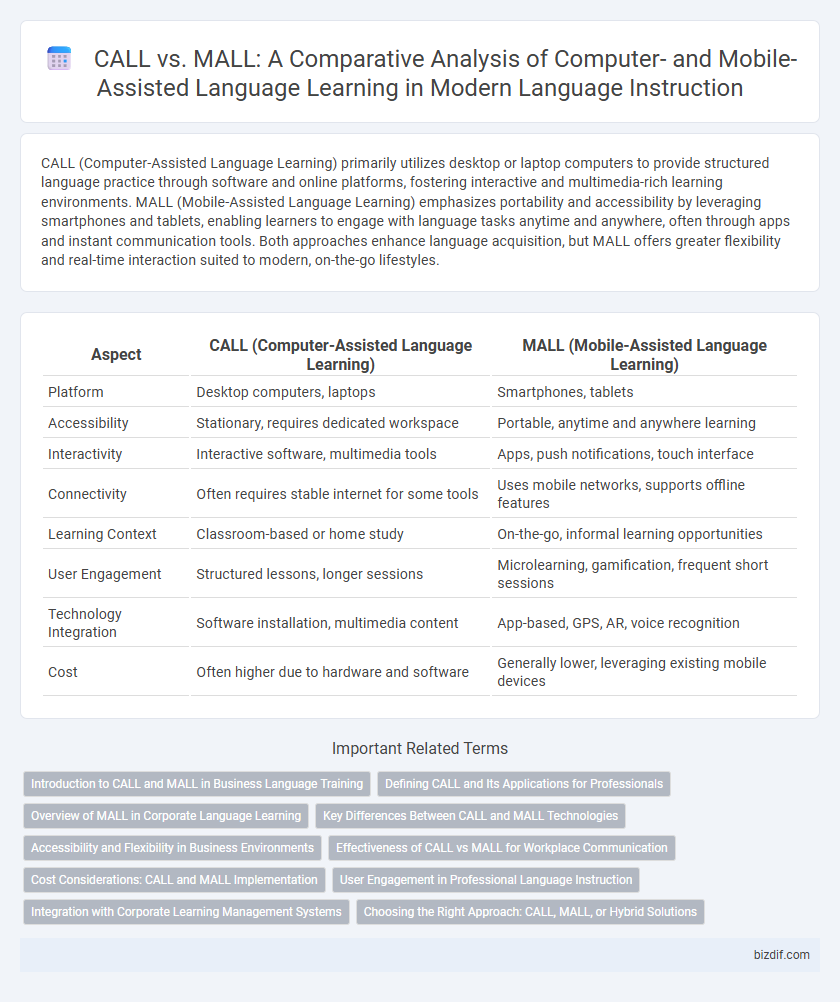CALL (Computer-Assisted Language Learning) primarily utilizes desktop or laptop computers to provide structured language practice through software and online platforms, fostering interactive and multimedia-rich learning environments. MALL (Mobile-Assisted Language Learning) emphasizes portability and accessibility by leveraging smartphones and tablets, enabling learners to engage with language tasks anytime and anywhere, often through apps and instant communication tools. Both approaches enhance language acquisition, but MALL offers greater flexibility and real-time interaction suited to modern, on-the-go lifestyles.
Table of Comparison
| Aspect | CALL (Computer-Assisted Language Learning) | MALL (Mobile-Assisted Language Learning) |
|---|---|---|
| Platform | Desktop computers, laptops | Smartphones, tablets |
| Accessibility | Stationary, requires dedicated workspace | Portable, anytime and anywhere learning |
| Interactivity | Interactive software, multimedia tools | Apps, push notifications, touch interface |
| Connectivity | Often requires stable internet for some tools | Uses mobile networks, supports offline features |
| Learning Context | Classroom-based or home study | On-the-go, informal learning opportunities |
| User Engagement | Structured lessons, longer sessions | Microlearning, gamification, frequent short sessions |
| Technology Integration | Software installation, multimedia content | App-based, GPS, AR, voice recognition |
| Cost | Often higher due to hardware and software | Generally lower, leveraging existing mobile devices |
Introduction to CALL and MALL in Business Language Training
CALL integrates multimedia resources and interactive software to enhance business language training, offering structured lessons that target professional vocabulary and communication skills. MALL leverages mobile technology to provide flexible, on-the-go language practice through apps and real-time interaction, supporting learner autonomy in business contexts. Both methods improve learner engagement and retention by incorporating technology tailored to workplace language needs.
Defining CALL and Its Applications for Professionals
CALL (Computer-Assisted Language Learning) integrates software and digital tools to facilitate language acquisition through interactive exercises, multimedia content, and real-time feedback. It is widely applied in professional settings for training language skills, enhancing communication competencies, and supporting distance learning for employees. CALL platforms often include virtual classrooms, language labs, and customizable modules tailored to specific industry terminologies and professional requirements.
Overview of MALL in Corporate Language Learning
MALL (Mobile-Assisted Language Learning) leverages mobile devices to provide flexible, on-the-go language instruction tailored for corporate environments. It enhances learner engagement through multimedia content, real-time feedback, and interactive app-based exercises optimized for smartphones and tablets. Integration of MALL in corporate language training leads to increased accessibility, personalized learning paths, and improved retention compared to traditional CALL (Computer-Assisted Language Learning) platforms.
Key Differences Between CALL and MALL Technologies
CALL technologies primarily utilize desktop or laptop computers, offering extensive multimedia resources and structured language exercises, while MALL leverages mobile devices to provide flexible, on-the-go learning experiences with features like speech recognition and location-based learning. CALL environments often support complex software and larger-scale content delivery, whereas MALL emphasizes accessibility, real-time feedback, and personalized learning through apps and portable connectivity. The key difference lies in device dependency and learning context, with CALL suited for controlled, comprehensive instruction and MALL facilitating spontaneous, context-aware language practice.
Accessibility and Flexibility in Business Environments
CALL platforms often require fixed computer setups, limiting accessibility for professionals working remotely or on-the-go, whereas MALL leverages smartphones and tablets, enabling seamless language instruction anytime and anywhere. This mobility enhances flexibility by accommodating varied business schedules and environments, promoting continuous learning without geographical constraints. Enterprises adopting MALL benefit from increased employee engagement and productivity through personalized, contextually relevant language training accessible through mobile devices.
Effectiveness of CALL vs MALL for Workplace Communication
CALL offers extensive resources and structured practice environments conducive to developing workplace communication skills through interactive simulations and feedback tools. MALL enhances real-time, contextual learning by enabling learners to practice language skills in authentic workplace settings via mobile apps and instant communication platforms. Combining CALL's comprehensive instruction with MALL's flexibility and immediacy results in more effective language acquisition for professional interactions.
Cost Considerations: CALL and MALL Implementation
CALL implementation often involves higher initial costs due to the need for specialized computer hardware and software licenses, while MALL leverages widespread mobile device availability, reducing infrastructure expenses. MALL platforms benefit from lower maintenance and update costs as mobile apps streamline content delivery, enhancing scalability for diverse learner populations. Cost efficiency in MALL supports flexible, anytime language practice, making it a financially viable alternative to the more resource-intensive CALL setups.
User Engagement in Professional Language Instruction
User engagement in professional language instruction is enhanced by CALL platforms through interactive multimedia content and structured feedback mechanisms, fostering deeper cognitive involvement. MALL leverages mobile device accessibility and personalized learning contexts, increasing learner autonomy and real-time language practice opportunities. Both methods improve engagement by integrating adaptive technologies tailored to professional learners' schedules and proficiency levels.
Integration with Corporate Learning Management Systems
CALL systems traditionally offer robust integration capabilities with corporate Learning Management Systems (LMS), enabling comprehensive tracking of learner progress and centralized content delivery. MALL platforms, while increasingly compatible with LMS through adaptive APIs and cloud-based interfaces, prioritize on-the-go accessibility and often support real-time language practice via mobile notifications. Combining the scalability of CALL with the flexibility of MALL enhances corporate language training by ensuring seamless LMS integration alongside user-friendly mobile engagement.
Choosing the Right Approach: CALL, MALL, or Hybrid Solutions
CALL offers extensive multimedia resources and structured learning environments ideal for desktop use, while MALL provides flexibility and on-the-go access through smartphones and tablets, enhancing language practice anytime. Hybrid solutions combine the comprehensive content and interactivity of CALL with the mobility and personalized learning features of MALL, catering to diverse learner needs. Selecting the optimal approach depends on factors like learner demographics, technological access, and instructional goals.
CALL (Computer-Assisted Language Learning) vs MALL (Mobile-Assisted Language Learning) Infographic

 bizdif.com
bizdif.com